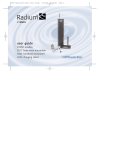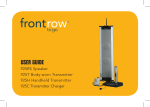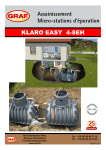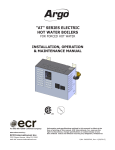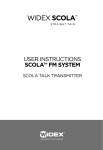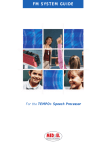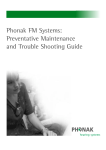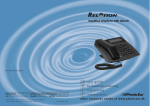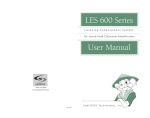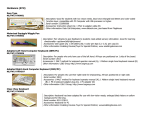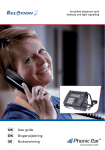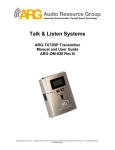Download Radio Shack 920SR User's Manual
Transcript
4724 Radium 216 User Guide 2/28/05 10:14 AM 216MHz user guide 920SR speaker 921T body-worn transmitter 922T handheld transmitter 923C charging stand Page 2 4724 Radium 216 User Guide 2/28/05 10:14 AM Page 6 contents introduction . . . . . . . . . . . . . . . . . . . . . . .1 understanding sound field . . . . . . . . . . . .2 setup tips . . . . . . . . . . . . . . . . . . . . . . .3-5 daily operating tips . . . . . . . . . . . . . . . .6-8 parts and accessories included with system . . . . . . . . . . . . . . . . . . . . .9-10 920SR column speaker features . . .11-14 921T body-worn transmitter features . .15-16 922T handheld transmitter features . . . .17 923C charging stand features . . . . . . . . .18 system setup and operation . . . . . .19-28 920SR speaker placement and mounting . . . . . . . . . . . . . . . . . . .29-34 921T body-worn transmitter operation . . . . . . . . . . . . . . . . . . . . . . . .35-40 922T handheld transmitter operation . . . . . . . . . . . . . . . . . . . . . . . .41-46 aux in – connecting to TV, CD, VCR, etc. . . . . . . . . . . . . . . . . . . . . .47 aux out – connecting to personal devices . . . . . . . . . . . . . . . . .48-49 additional system accessories . . . . . .50-51 troubleshooting . . . . . . . . . . . . . . . . .52-53 Radium channel numbers and corresponding frequencies . . . . . . . . . . . .54 product specifications . . . . . . . . . . . . .55-57 warranty . . . . . . . . . . . . . . . . . . . . . .58-60 regulatory approvals and clearances . .61-64 4724 Radium 216 User Guide 2/28/05 10:14 AM Page 7 introduction Congratulations on the purchase of your new Radium sound field system! With proper care and use it will become one of your most valuable classroom educational tools. Students will be able to consistently and easily understand the teacher, regardless of their location in the classroom, or competing internal or external background noise. Teachers can now speak all day in their normal voice without having to raise their voice to get their students’ attention. Numerous studies show that classrooms using sound field enjoy better student comprehension, increased student participation, better grades and fewer behavioral referrals. Read this manual carefully to become familiar with your system and to get the most out of its many features and options. 1 4724 Radium 216 User Guide 2/28/05 10:14 AM Page 8 understanding sound field and its benefits without sound field ? ? co ug h! • distance • noise • echo with sound field • distance • noise • echo 2 4724 Radium 216 User Guide 2/28/05 10:14 AM Page 9 setup tips IMPORTANT! Be sure you place your Radium speaker and transmitter units on their charger overnight – for a minimum of 12 hours – before turning the power on and/or using them for the first time. Failing to do so can reduce battery capacity. Basic setup tips First – Identify a front corner of the room – the location from where the teacher normally teaches. Second – Take a good look around, paying close attention to power outlet and other electronic equipment locations. Ideally, the speaker should be placed at a 5-foot distance from other electronic equipment, such as computers or radios. Third – Determine whether to mount the speaker on the wall as shown in diagram 1, or place it on a sturdy surface using the T-bar table 3 diagram 1 4724 Radium 216 User Guide 2/28/05 10:14 AM Page 10 setup tips (cont’d) mount stand in diagram 2. In either case, the speaker should be placed at a height of 3 feet/1 meter from the floor, or at level closest to the listener‘s ears. diagram 2 Fourth – Consider whether other Radium, EasyListener 2, or other radio-based active learning systems are in use in the building, and set transmitter and receiver channels accordingly. Every transmitter in a building should be on its own channel. See diagrams in section 12 for guidance. If placing the speaker on a table or surface top, consider the following: • Choose a location that provides easy access for the teacher, and is out of the way of students and main traffic areas. The speaker should be placed at least 6 feet/1.8 meters away from where the teacher stands. 4 4724 Radium 216 User Guide 2/28/05 10:14 AM Page 11 setup tips (cont’d) • Choose a table or surface top that is sturdy. Make sure the table or cabinet is structurally solid, sturdy and out of the way of foot traffic. • Properly mount and securely fasten the T-bar speaker stand onto the bottom of the speaker. Make sure the stand is screwed on tightly, and that the speaker does not wobble when in an upright position. If mounting on the wall, consider the following: • The power supply cord needs to reach the wall outlet. Make sure the power supply is within reach of the speaker from its wall-mounted position. • The teacher should be able to reach the controls located on top of the speaker once it’s mounted. Once the volume is set at a comfortable level, the speaker power switch located on the lower right side of the speaker can be easily accessed by the teacher. Follow the instructions on page 28 for setting the volume at the proper level. • Never mount the speaker upside down, or horizontally. The speaker unit must be mounted such that the controls are located at the top of the unit. 5 4724 Radium 216 User Guide 2/28/05 10:14 AM Page 12 daily operating tips In the morning – • Turn transmitter power ’on’ and put microphone on. • Turn speaker column power ’on’. The speaker should remain plugged into a wall power outlet during the day – with the power in the ‘on’ position. Turn power switch to the ‘off’ position at night after each use. The internal battery is not being used while the speaker is plugged into a wall outlet. • To operate using the internal battery as a portable system, simply unplug the speaker before use and plug back in after use – making sure you return power switch to ‘off’ position while plugged-in and charging. The battery takes 6 hours to reach a full charge; at full charge, the speaker column battery will last up to 8 hours unplugged. In the evening after each use – • Turn transmitter power ’off ’, and place it back onto the charging stand; confirm that the ‘charge’ indicator light illuminates. Transmitters not in use should always be placed on the charging stand – this is their home base station. • Turn speaker column power ’off ’. Leave speaker plugged into wall power outlet, but confirm that the power has been turned ‘off.’ 6 4724 Radium 216 User Guide 2/28/05 10:14 AM Page 13 daily operating tips (cont’d) Battery care and maintenance tips – • The speaker battery will last approximately 2 years depending on usage. • When not in use, leave speaker plugged into wall outlet with power switch in ‘off ’ position. • Keep speaker away from heating units – use/store in a cool dry place. • When using speaker battery power (unplugged from wall), always remember to return power switch to ‘off ’ position after use. • Never mount/use speaker horizontally or upside down. Controls should be accessible from top of unit. • Plan on buying new NiMH batteries for your transmitter every 12 months. Alkaline batteries can also be used as back-ups, however, the 923C charger will not recharge alkaline batteries. Never attempt to recharge alkaline batteries – this will cause damage to the unit and void the product warranty. • Remember to charge all batteries overnight before initial use. 7 4724 Radium 216 User Guide 2/28/05 10:14 AM Page 14 daily operating tips (cont’d) Do not coil the microphone – since it also acts as your antenna, coiling or wrapping the cord will affect its range and may also reduce its life. Speak at a normal level – the system is projecting your voice for you. 8 4724 Radium 216 User Guide 2/28/05 10:14 AM Page 15 parts and accessories included with system 1 3 2 4 and/ or 6 5 9 9 8 7 or 10 11 12 13 4724 Radium 216 User Guide 2/28/05 1 column speaker receiver (920SR) 2 body-worn transmitter (921T) and/or handheld transmitter (922T) 10:14 AM 3 plug-in mic for body-worn transmitter (AT0655 shown) 4 charging stand (923C) 5 6 7 power supply, receiver (040-7402-106) power supply, charging stand (AT0819) receiver antenna (AT0831) Page 16 8 speaker table stand (AT0823) or wall mounting bracket (set of 2) (AT0820) 9 elastic belt (AT0712) 10 AA rechargeable NiMH batteries (AT0807) 11 channel changer screwdriver (330-3000-101) 12 auxiliary input/output cable (AT0532-05) 13 auxiliary input cable (3.5mm – dual RCA) (300-6332-107) 10 4724 Radium 216 User Guide 2/28/05 10:14 AM Page 17 920SR column speaker features (top) 8 9 10 11 12 1 2 11 3 4 5 6 7 4724 Radium 216 User Guide 2/28/05 1 power, low battery, and reception status indicator for channel A 2 power switch and volume control for channel A 3 reception status indicator for channel B 4 power switch and volume control for channel B 5 tone control 6 aux input volume control 10:14 AM Page 18 7 aux output level switch See page 42 for level setting chart 8 antenna 9 wall mount hole 10 extra antenna hole (not used) 11 aux input jack (3.5mm, mono) 12 aux output jack (3.5mm, mono) 12 4724 Radium 216 User Guide 2/28/05 10:14 AM Page 19 920SR column speaker features (front and back) 20 13 14 16 15 18 17 13 19 4724 Radium 216 User Guide 2/28/05 10:14 AM Page 20 13 speaker grille 19 power jack 14 two built-in speakers 20 channel selectors 15 internal rechargeable battery (non-user removable) 16 handle 17 main power on/off switch 18 power and charging indicator 14 4724 Radium 216 User Guide 2/28/05 10:14 AM Page 21 921T body-worn transmitter features front back 3 1 4 2 15 4724 Radium 216 User Guide 2/28/05 10:14 AM Page 22 921T body-worn transmitter features (cont’d) top 5 6 1 belt clip 2 battery compartment 3 volume control 4 channel selector 5 microphone input (2.5mm) 6 3 position power switch 7 on 7 standby (mute) off power and low battery indicator light 16 4724 Radium 216 User Guide 2/28/05 10:14 AM Page 23 922T handheld microphone features 1 LED indicator light 2 3 position power switch 1 on 2 3 4 5 17 standby (mute) off 3 channel selector 4 battery compartment 5 channel selector key (inside battery compartment) 4724 Radium 216 User Guide 2/28/05 10:14 AM Page 24 923C charging stand features front 1 2 3 4 5 back 6 1 power indicator 2 pocket 1 charging indicator 3 pocket 1 full charge indicator 4 pocket 2 charging indicator 5 pocket 2 full charge indicator 6 power switch 7 DC power socket 7 18 4724 Radium 216 User Guide 1 2/28/05 Page 25 system setup and operation attach antenna 2 1 19 10:14 AM 1 Attach antenna to top of speaker 2 Turn metal base of antenna clockwise until secured tightly (do not over-tighten) 4724 Radium 216 User Guide 2 2/28/05 10:14 AM Page 26 turn on main power if using wall outlet 1 Plug power supply into power/charging socket 2 Plug power supply into wall socket 3 Turn speaker on 2 1 if using already charged battery 3 3 Turn speaker on NOTE: Light is not illuminated during normal battery operation NOTE: Battery operating time is 5-8 hours. 20 4724 Radium 216 User Guide 3 2/28/05 10:14 AM Page 27 charge battery charge nightly after every use 2 1 1 Plug power supply into power/charging socket 2 Plug power supply into wall socket Recharging time is 8 hours if the battery is completely discharged and 4 to 7 hours if battery is only partially discharged. Red light = charging Flashing red/green (equal duration) = 80 -90% charged Long flash green, short flash red = fully charged NOTE: Light is not illuminated during normal battery operation 21 NOTE: Battery operating time is 5-8 hours. 4724 Radium 216 User Guide 4 2/28/05 10:14 AM Page 28 insert batteries in body-worn transmitter 1 3 _ + 2 + _ 1 Switch power off 2 Remove battery cover (push and slide off) 3 Insert two AA rechargeable NiMH batteries WARNING: Never recharge alkaline batteries! This will cause damage to the unit and will void the product warranty. 22 4724 Radium 216 User Guide 5 + Page 29 1 1 Switch power off 2 Remove battery cover (turn counter-clockwise) 3 Insert two AA rechargeable NiMH batteries _ 3 + 2 23 10:14 AM insert batteries in handheld microphone AA Rechargeable NiMH batteries _ 2/28/05 WARNING: Never recharge alkaline batteries! This will cause damage to the unit and will void the product warranty. 4724 Radium 216 User Guide 6 2/28/05 10:14 AM Page 30 charge transmitter(s) Never attempt to recharge alkaline batteries! This will cause damage to the unit and will void the product warranty. charger back 1 Plug power supply into power jack on back of charger stand 2 Plug power supply (AT0819) into wall socket 3 Turn charger on 4 Turn transmitters off while charging 5 When green charge ready indicator lights, the transmitter batteries are full charged and ready to go. (4 to 5 hours) 2 3 1 charger front 4 4 5 24 4724 Radium 216 User Guide 7 10:14 AM Page 31 wait until green charge indicators light (4-5 hours) 1 2 4 25 2/28/05 3 1 PWR: Red light = charger is turned on 2 CHARGING: Amber light = units are being charged 3 READY: Green light = units are fully charged 4 ERROR: Blinking Amber light = charging error. Improper batteries have been detected. Check your batteries and replace as required. Only NiMH AA batteries can be charged. Unit will not charge disposable Alkaline batteries or NiCad batteries. 4724 Radium 216 User Guide 10:14 AM Page 32 select channel 1 921T 1 m at ch 8 2/28/05 ch at m 922T Use a screwdriver to adjust the Channel A selector on the back of the speaker to match the channel number of either the 921T and/or the 922T transmitter(s). NOTE: Consider whether other Radium, EasyListener 2, or other radio-based active learning systems are in use in the building, and set transmitter and receiver channels accordingly. Every transmitter in a building should be on its own channel. See diagrams in section 12 for guidance. 26 4724 Radium 216 User Guide 9 10:14 AM Page 33 activate receivers 2 27 2/28/05 3 1 Turn receiver on by turning Channel A and/or Channel B volume control knob(s) to the right 2 Check power indicator light (remember that main power must also be on – see 2 ): Flash red once = adequate power Continuous red = low battery No light = battery does not have power and requires recharging or power supply is not connected properly 3 Turn on a 921T or 922T transmitter and check FM indicator light(s): Green = receiving FM signal 1 4724 Radium 216 User Guide 10 2/28/05 10:14 AM Page 34 setting FM volume Follow steps 1 or 2 below to adjust FM volume setting to proper level. Two people are needed to set the volume level. It is difficult to hear your own voice and make adjustments to it. NOTE: The average volume setting is in the 11:00 position (see photo), but may change depending on room acoustics and noise level. 1 With a sound level meter - Take a level reading in the “A” setting in the center of the 2 Without a sound level meter - First, ask someone other than yourself (if you are the teacher) to listen to the amplified voice and make volume adjustments. An ideal volume level is achieved when the listener can hear the amplified voice at a comfortable level and the volume level from the speaker and teacher’s mouth is comparable. If you can hear yourself through the loudspeakers, the volume setting may be too high and should be decreased. room during normal classroom activity, and another reading of the teacher's amplified voice (without the class activity). The level of the teacher's voice should be set between 10-15 decibels above room noise level. 28 4724 Radium 216 User Guide 11 2/28/05 10:14 AM Page 35 920SR speaker placement and mounting speaker positioning Place speaker in a corner of the room facing listeners. Mount speaker on wall using brackets or place speaker on a surface using a speaker stand. The bottom of the speaker should be about 1 meter/3 feet from the floor. (See setup tips on page 3). 1m/3ft 29 4724 Radium 216 User Guide 12a 2/28/05 10:14 AM Page 36 channel mapping: placement diagram for multiple system installations (double channel - 8 rooms total) = suggested placement of 920SR speaker Channel A: 44 Channel B: 54 Channel A: 41 Channel B: 51 Channel A: 46 Channel B: 56 Channel A: 42 Channel B: 52 Channel A: 47 Channel B: 57 Channel A: 43 Channel B: 53 hallway Channel A: 48 Channel B: 58 Channel A: 45 Channel B: 55 30 4724 Radium 216 User Guide 12b 2/28/05 10:14 AM Page 37 channel mapping: placement diagram for multiple system installations (single channel - 16 rooms total) Channel: 42 Channel: 43 Channel: 44 Channel: 45 Channel: 46 Channel: 47 Channel: 48 Channel: 51 Channel: 52 Channel: 53 Channel: 54 Channel: 55 Channel: 56 Channel: 57 Channel: 58 31 hallway hallway Channel: 41 4724 Radium 216 User Guide 13a 2/28/05 10:14 AM Page 38 wall mounting (option 1) 2 AT0820 1 Attach brackets to wall 2 Screw mounting brackets to top and bottom of speaker 1 32 4724 Radium 216 User Guide 13b 2/28/05 10:14 AM Page 39 mounting on floor stand (option 2) 1 Screw speaker stand into hole on bottom of speaker. • Turn clockwise to tighten • Turn counter-clockwise to loosen 1 AT0823 AT0824 floor stand is also available 33 4724 Radium 216 User Guide 13c 2/28/05 10:15 AM Page 40 seal wall mounting hole if using table stand 1 Place plastic plug into mounting bracket hole on top of speaker to keep out dust 1 34 4724 Radium 216 User Guide 14 2/28/05 Page 41 921T body-worn transmitter operation plug microphone in Boom mic cord 1 35 10:15 AM 1 Plug microphone cord into mic jack on top of body-worn transmitter 4724 Radium 216 User Guide 15 2/28/05 10:15 AM Page 42 put on microphone and adjust for proper distance from mouth Maximum distance from mic to mouth is 6 in/(15cm); 3 in/(7.5cm) is ideal. optimum optional AT0655 boom mic (two wearing options) performance: ★★★★ 7.5cm/3in AT0816 collar mic performance: ★★★ AT0814 earhook mic performance: ★★★★ 15cm/ 6in max. AT0291-L directional lapel mic performance: ★★ 36 4724 Radium 216 User Guide 16 2/28/05 10:15 AM Page 43 turn power on 1 2 1 Switch power on 2 Check indicator light: Continuous green = adequate power Continuous red = low battery battery life NiMH rechargeable AA = 12 hours (approx.) Alkaline disposable AA = 15 hours (approx.) WARNING: Never recharge alkaline batteries! This will cause damage to the unit and will void the product warranty. 37 4724 Radium 216 User Guide 17 2/28/05 10:15 AM Page 44 adjust transmitter(s) frequency 1 1 Use a screwdriver to turn frequency selector to channel number that matches the channel set on column speaker 2 If using both body-worn and handheld transmitters set one transmitter channel to match a Channel A on the speaker column, and the other transmitter channel to match a Channel B channel on the speaker column. must match ch at 921T tm us m 2 922T 920SR NOTE: Never operate two transmitters on the same channel or interference will result. To use two transmitters, set the first to match receiver Channel A and the second to match receiver Channel B. 38 4724 Radium 216 User Guide 18 1 2 39 2/28/05 10:15 AM Page 45 adjust body-worn transmitter volume 1 Increase transmitter volume for greater mic sensitivity and sound clarity 2 Reduce transmitter volume if feedback occurs 4724 Radium 216 User Guide 19 2/28/05 10:15 AM Page 46 activate standby/mute mode 1 Activate standby mode to eliminate white noise when not speaking 1 MUTE: Standby mode can also be used as a microphone/transmitter mute switch. The mute feature allows teachers to have a private conversation without needing to turn the transmitter off. 40 4724 Radium 216 User Guide 20 2/28/05 10:15 AM Page 47 922T handheld transmitter operation turn power on 1 1 41 Turn power on by pushing power switch up 4724 Radium 216 User Guide 21 2/28/05 10:15 AM Page 48 check indicator light 1 Check indicator light: Continuous green = adequate power Continuous red = low battery 1 battery life NiMH rechargeable AA = 12 hours (approx.) Alkaline disposable AA = 15 hours (approx.) WARNING: Never recharge alkaline batteries! This will cause damage to the unit and will void the product warranty. 42 4724 Radium 216 User Guide 22 2/28/05 Page 49 remove channel adjustment key 2 1 43 10:15 AM 1 Open battery compartment door and remove batteries 2 Remove channel adjustment key 4724 Radium 216 User Guide 23 2/28/05 10:15 AM Page 50 adjust transmitter channel to match receiver channel 1 1 tm us m ch at Using adjustment key, turn channel frequency selector to channel number that matches the channel set on column speaker NOTE: Never operate two transmitters on the same channel or interference will result. To use two transmitters, set the first to match receiver Channel A and the second to match receiver Channel B. 920SR 44 4724 Radium 216 User Guide 24 2/28/05 10:15 AM Page 51 standby mode 1 1 45 Activate standby mode to mute voice and eliminate white noise when not speaking 4724 Radium 216 User Guide 25 2/28/05 10:15 AM Page 52 transmitters that can be used with 920SR receiver/speaker ★★★★ = most compatible transmitter compatible (no adaptor cord required) ★ = least compatible performance rating accessory needed comments 921T Radium 922T Radium 330T EasyListener 2 300TS-216 Sprite Lexis transmitter (as mic) ✔ ★★★★ none ✔ ★★★★ none ✔ ★★★★ none ✔ ★★★ none ✔ ★★★ ✔ a) Lexis requires the use of the AT0655R boom mic b) may require use of external antenna for better range (389-02-120-02) c) set microphone to omni mode d) set sensitivity level to HI Phonak Campus S TX5 ✔ ★★★ ✔ due to feedback, use of external boom mic from Phonak is recommended Phonak HandyMic TX3 N/A N/A N/A best when used with AT0655 boom mic a) built-in mic prone to feedback b) requires use of external mic, which the HandyMic does not accommodate 46 4724 Radium 216 User Guide 26 2/28/05 10:15 AM Page 53 aux in – connecting to TV, CD, VCR, etc. connecting speaker to TV, CD, VCR, etc. 1 Using either the AT0532-05 or 300-6332-107 adaptor cords, connect VCR, TV, CD, computer or other audio source to AUX IN port on top of speaker 2 Use AUX IN VOLUME control to adjust volume 1 2 AT0532-05 or 300-6332-107 VCR 47 NOTE: AUX IN can be used simultaneously with both Channel A & B. 4724 Radium 216 User Guide 27 2/28/05 10:15 AM aux out – connecting to personal FM devices connecting to SOLARIS, EASY LISTENER, SPRITE or other transmitter (for rebroadcast of audio to students with hearing impairment) 1 1 3 with transmitter system) to Mic/Ant jack on transmitter Aux In 3 1 2 PE 571T OR PE 300T Connect AT0532-05(ft) cord to AUX input jack of either SOLARIS, EASY LISTENER, SPRITE, or other transmitter. Connect other end of cable to AUX OUT port on top of speaker. 2 Connect antenna AT0529A (included AT0532-05 AT0529A Ant jack Page 54 OR Refer to level setting gide on next page to identify proper level for your transmitter PE 300TS 48 4724 Radium 216 User Guide 28 2/28/05 10:15 AM Page 55 aux out transmitter compatibility chart and level setting guide NOTE: Common transmitters and recommended level settings are shown below. Because the level setting is universal, other transmitters not listed below may be used as well – simply set the aux out level to the position at which the receiver wearer hears a strong distortion-free signal. product name/part aux in jack size aux out level setting Easy Listener 300T Sprite 300TS Sprite 300TS-216 Solaris 571T Lexis 871T transmitter Phonak Campus S TX5 Phonak HandyMic TX3 Phonak MicroVox TX2 3.5mm 3.5mm 3.5mm 3.5mm 3.5mm 3.5mm 3.5mm† 2.5mm* High High High High High High High High * For transmitters with a 3.5mm jack size, simply attach the transmitter to the AT0805 aux out accessory cord. For 2.5mm products, use the aux out adapter plug (310-2544-1341) † Requires special adaptor cord provided by Phonak (P/N 52117) and Radio Shack adaptor (P/N 274387). 49 4724 Radium 216 User Guide 2/28/05 10:15 AM Page 56 additional system accessories microphone options AT0655 AT0814 AT0816 AT0291-L behind-the-neck boom microphone earhook microphone FM collar microphone with mute switch directional microphone with lavalier cord receiver accessories AT0820 AT0823 AT0824 wall mounting bracket (set of 2) speaker table stand speaker floor stand AT0822 carrying bag AT0801 aux-box (adds four additional audio inputs) 50 4724 Radium 216 User Guide 2/28/05 10:15 AM Page 57 additional system accessories (cont’d) transmitter accessories AT0532-15 auxiliary input/ output cable (3.5mm–dual RCA) (15ft/4.6m) 51 AT0529A transmitter antenna 310-2544-1341 AT0807 aux-out adaptor plug (3.5mm– 2.5mm) AA rechargeable NiMH batteries 4724 Radium 216 User Guide 2/28/05 10:15 AM Page 58 troubleshooting no FM reception (Channel A, Channel B indicator does not have green light) speaker is receiving a signal but no sound is coming out • Verify the transmitter is turned on • Verify microphone is connected properly to transmitter and is working correctly • Verify the frequency number on the transmitter matches the frequency number on receiver • Verify transmitter batteries are charged • Verify speaker antenna is connected properly weak sound from speaker • Increase volume on the speaker feedback from speaker • Turn down the volume on the transmitter • Turn down the volume on the speaker • Make sure the person wearing the transmitter is not too close to the speaker • Turn up transmitter volume • Move speaker so that it is facing away from presenter and toward listeners • Make sure AT0655 boom microphone (or other mic) is being worn correctly • Make sure AT0655 boom microphone (or other mic) is being worn correctly 52 4724 Radium 216 User Guide 2/28/05 10:15 AM Page 59 troubleshooting (cont’d) speaker does not turn on (power indicator does not flash red) speaker is picking up FM interference or hum • Verify main power switch on the bottom of the unit is turned on • Check to make sure no other wireless systems are operating on similar frequencies • Verify Channel A and Channel B volume control knobs are turned on • Check to make sure the system is not placed too close to a computer • Verify power supply is plugged securely into speaker and wall socket • Check to make sure metal objects are not placed too close to transmitter or speaker (i.e. jewelry, metal shelves) • Verify wall socket works speaker battery does not charge • Connect power supply to speaker and charge for four hours. If speaker battery does not hold a charge, send the unit to Phonic Ear Service department for replacement (battery must be replaced after one year of continuous use). 53 amber charge light is flashing when I attempt to charge my transmitter • Replace your batteries with a set of new NiMH cells (AT0807). 4724 Radium 216 User Guide 2/28/05 10:15 AM Page 60 Radium channel numbers and corresponding frequencies Channel # Channel A Channel # Channel B 41 . . . . . . . . . . . 216.025 MHz 51 . . . . . . . . . . 216.525MHz 42 . . . . . . . . . . . 216.075MHz 52 . . . . . . . . . . 216.575MHz 43 . . . . . . . . . . . 216.125MHz 53 . . . . . . . . . . 216.625MHz 44 . . . . . . . . . . . 216.175MHz 54 . . . . . . . . . . 216.675MHz 45 . . . . . . . . . . . 216.225MHz 55 . . . . . . . . . . 216.725MHz 46 . . . . . . . . . . . 216.275MHz 56 . . . . . . . . . . 216.775MHz 47 . . . . . . . . . . . 216.325MHz 57 . . . . . . . . . . 216.825MHz 48 . . . . . . . . . . . 216.375MHz 58 . . . . . . . . . . 216.875MHz 54 4724 Radium 216 User Guide 2/28/05 10:15 AM Page 61 product specifications two channel column speaker: 920SR carrier frequency range/ frequencies modulation output power power requirements frequency response total harmonic distortion system signal-to-noise ratio FM (F3E) dimensions (W x H x D) weight recharging time maximum 36W @ 4Ω x 2 110V/240V AC adaptor 15V DC/2A, Battery 12V/2.7A (rechargeable, sealed lead-acid, 1-1.5 year life with continuous usage) 100Hz – 9kHz <2% >65 dB (at rated output) inputs AUX x 1, power & charge output AUX x 1 (High: 700 mV/Low: 100mV) controls 55 216.025 –216.875MHz 16 total tone, channel A & channel B power/volume, aux volume, high/low output, master power, channel selector battery operating time speaker stand 100 x 660 x 145 mm/ 3.9 x 26 x 5.7 in 5kg/11lbs 8 hours for initial charging 4 – 7 hours for recharging 5 – 8 hours (continuous operation) optional table stand (AT0823), floor stand (AT0824), or wall brackets (AT0820) de-emphasis 75µs squelch RSSI 4724 Radium 216 User Guide 2/28/05 10:15 AM Page 62 product specifications (cont’d) body-worn transmitter: 921T carrier frequency range/ frequencies modulation total harmonic distortion frequency response frequency stability maximum modulation pre-emphasis dynamic range operating range dimensions (WxHxD) weight controls inputs/outputs 216.025 –216.875MHz 16 total FM (F3E) <1.5% 50Hz to 12KHz .0005% battery battery life recharging time NiMH rechargeable (1600mA); alkaline disposable (2AA) NiMH rechargeable: 12 hours (approx.) alkaline disposable: 15 hours (approx.) 6 hours ± 25KHz, with level limiting 75µs 100dB >34m/110ft 65 x 90 x 25 mm/ 2.5 x 3.5 x 1 in 51g/1.8oz on/standby/off/channel selector/volume 2.5mm microphone input jack 56 4724 Radium 216 User Guide 2/28/05 10:15 AM Page 63 product specifications (cont’d) handheld mic transmitter: 922T carrier frequency range/ frequencies mic 216.025 –216.875MHz 16 total (see chart below) antenna built-in 15mW battery life NiMH rechargeable battery; alkaline disposable; 1.5V x 2 AA NiMH rechargeable: 12 hours (approx.) alkaline disposable: 15 hours (approx.) recharging time 6 hours (NiMH batteries) dimensions (dia x length) 54 x 237 mm/2.1 x 9.3 in weight controls 57 power supply indicator lights dynamic microphone RF output battery charging stand: 923C 230g/8.1oz on/standby/off/channel selector recharging time dimensions (WxHxD) AC adaptor (DC 12V/ 0.5A) LED green = battery ready LED orange = recharging LED red = power on LED blinking orange = fault (battery bad) NiMH (1300mA): 4 hr 135 x 47 x 230 mm/5.3 x 1.9 x 9 in weight 360g/12.7oz controls on/off switch 4724 Radium 216 User Guide 2/28/05 10:15 AM Page 64 warranty time period of warranty This warranty will go into effect upon the date of purchase and will stay in effect as long as the instrument remains the property of the original owner. EASYLISTENER 2™, VOCALIGHT™ and ONWAVE™ have a 3-year warranty. All other products have a 1 year warranty. what is covered by this warranty Any electronic component, which because of workmanship, manufacturing or design defects, fails to function properly under normal use during the life of this warranty will be replaced or repaired at no charge for parts or labor, when returned to the factory service center. Transportation in is paid by the customer. If it is determined that repair is not feasible, the entire unit may be replaced with an equivalent unit upon mutual agreement of the manufacturer and customer. what is not covered by this warranty This limited warranty does not apply to: 1. Malfunctions resulting from abuse, neglect or accident 2. Instruments connected, installed, used or adjusted in any manner contrary to instructions provided by the manufacturer 3. Consequential damages and damages resulting from delay or loss of this instrument. The exclusive remedy under this warranty is strictly limited to repair or replacement as herein provided 4. Products damaged in transit unless investigated by the shipper and returned to the warrantor with the investigation report 5. Peripheral accessories as itemized within the product specification sheet as applicable, when such items are not returned within 1 year from original purchase 6. Batteries if applicable 58 4724 Radium 216 User Guide 2/28/05 10:15 AM Page 65 warranty (cont’d) Phonic Ear Inc. reserves the right to make changes in the design or construction of any of its instruments at any time without incurring any obligation to make any changes whatsoever on units previously purchased. This warranty is in lieu of all other expressed warranties. All expressed and implied warranties will terminate upon the expiration of this written warranty. No representative or person is authorized to represent or assume for us any liability in connection with the sale or use of our products other than as set forth above. what to do if you have questions If you have any questions about service, call the service department at 800.227.0735, then press 7. what to do if you need service If you require service under the warranty terms, obtain a service order form either online at www.phonicear. com/support.asp or through our U.S. customer service department at 800.227.0735, then press 5 (or +1.707.769.1110 outside the U.S.). Fill the form out completely remembering to include: 1. Description of the problem 2. Your billing address 3. Your shipping address (if different from billing address) 4. Contact name and phone number 5. A P.O. number if the equipment is not under a warranty or service contract 59 4724 Radium 216 User Guide 2/28/05 10:15 AM Page 66 warranty (cont’d) Then, carefully package the equipment in the original shipping container to prevent damage and send it postpaid to the service center near you: USA/International: Phonic Ear Inc. 3880 Cypress Drive Petaluma, CA 94954-7600 U.S.A. In Canada: Phonic Ear Ltd. 10-7475 Kimbel Street Mississauga, Ontario L5S 1E7 Canada what to do if you have questions If you have any questions about service, call the service department at 800.227.0735, then press 7. about your batteries To ensure that your batteries are as fresh as possible upon arrival, we have intentionally not installed them in your equipment. install your batteries in your equipment now, then charge overnight before initial use (see user guide for charging procedure). avoid battery corrosion To avoid battery corrosion and damage to your equipment, do not recharge disposable or rechargeable alkaline batteries. Before charging any Phonic Ear equipment make sure only NiMH rechargeable batteries are installed. As an added precaution, remove batteries if the equipment will not be used for several weeks. 60 4724 Radium 216 User Guide 2/28/05 10:15 AM Page 67 regulatory approvals and clearances transmitter This transmitter is authorized by rule under the Low Power Radio Service (47 C.F.R. Part 95) and must not cause harmful interference to TV reception or United States Navy SPASUR installations. You do not need an FCC license to operate this transmitter. This transmitter may only be used to provide: auditory assistance to persons with disabilities, persons who require language translation, or persons in educational settings; health care services to the ill; law enforcement tracking services under agreement with a law enforcement agency; or automated maritime telecommunications system (AMTS) network control communications. Two-way voice communications and all other types of uses not mentioned above are expressly prohibited. This device may not interfere with TV reception or federal government radar, and must accept any interference received, including interference that may cause undesired operation. 61 IMPORTANT NOTE: To comply with FCC RF exposure compliance requirements, only use supplied antenna that is sold with this transmitter. Use of any other antenna which has not been approved by the manufacturer will violate FCC rules and regulation and void the user’s authority to operate this device. This device and its antenna(s) must not be co-located or operating in conjunction with any other antenna or transmitter. 4724 Radium 216 User Guide 2/28/05 10:15 AM Page 68 regulatory approvals and clearances (cont’d) receiver: part 15, subpart B Radium Receiver/Speaker 920SR Tested to comply with FCC Standards FOR HOME OR OFFICE USE This equipment has been tested and found to comply with the limits for a Class B digital device, pursuant to Part 15 of the FCC Rules. These limits are designed to provide reasonable protection against harmful interference in a residential installation. This equipment generates, uses and can radiate radio frequency energy and, if not installed and used in accordance with the instructions, may cause harmful interference to radio communications. However, there is no guarantee that interference will not occur in a particular installation. If this equipment does cause harmful interference to radio or television reception, which can be determined by turning the equipment off and on, the user is encouraged to try to correct the interference by one or more of the following measures: • Reorient or relocate the receiving antenna. • Increase the separation between the equipment and receiver. • Connect the equipment into an outlet on a circuit different from that to which the receiver is connected. • Consult the dealer or an experienced radio/TV technician for help. 62 4724 Radium 216 User Guide 2/28/05 10:15 AM Page 69 regulatory approvals and clearances (cont’d) FCC notes The Radium sound field system is approved by the FCC (Federal Communications Commission). The use of the system may be governed by specific FCC rules and FCC licensing or notifications may be required. Consult your local FCC office for detailed information. Phonic Ear FM receivers and FM transmitters, when required, are approved by the Federal Communications Commission (FCC) in the U.S. and Industry Canada. Other government approvals are available upon request. (Other international regulations may also apply.) Any changes or modifications made to any government-approved element of this instrument, without the express approval of Phonic Ear Inc in writing, could void the user's authority to operate those elements of the system. 63 Part 95 This transmitter is authorized by rule under the Low Power Radio Service (47 CFR Part 95) and must not cause harmful interference to TV reception or United States Navy SPASUR installations. You do not need an FCC license to operate this transmitter. This transmitter may only be used to provide auditory assistance to persons with disabilities, persons who require language translation, or persons in educational settings; health care services to the ill; law enforcement tracking service under agreement with a law enforcement agency; or automated maritime telecommunication system (AMTS) network control communications. Two-way voice communications and all other types of uses not mentioned above are expressly prohibited. 4724 Radium 216 User Guide 2/28/05 10:15 AM Page 70 regulatory approvals and clearances (cont’d) This device may not cause interference and must accept any interference received, including interference that may cause undesired operation. These devices may not interfere with TV reception or Federal Government radar. IC notes This Class B digital apparatus complies with Canadian ICES-003. Cet appareil numérique de la classe B est conforme à la norme NMB-003 du Canada. The term "IC:" before the radio certification number only signifies that Industry of Canada technical specifications were met. If TV channel 13 is used in the area, the installer shall reduce or adjust the RF radiated power so that near-by TV channel 13 receivers do not receive radio interference from the system installed. Suggestions: A test with a TV receiver equipped with "rabbit-ear antenna" and tuned to channel 13 should be conducted, at the perimeter of the users' intended coverage area and not over-lapping other user's areas without the latter's consent. If this does not solve the problem, a channel near the 217 MHz edge and not near 216 MHz should be tried. This product has been cleared by the U.S. Food and Drug Administration for use by persons with normal hearing and hearing impairment. 64 4724 Radium 216 User Guide 2/28/05 10:14 AM Page 1 u.s.a. 800.227.0735, then press 5 • canada 800.263.8700 • international +45 3917 7101 © 2005 Phonic Ear Inc. Phonic Ear and the names of Phonic Ear products are trademarks or registered trademarks of Phonic Ear Inc. in the U.S. and other countries. Product specifications and accessories subject to change without notice. 821-7403-101/Rev. D/4724 0205



































































